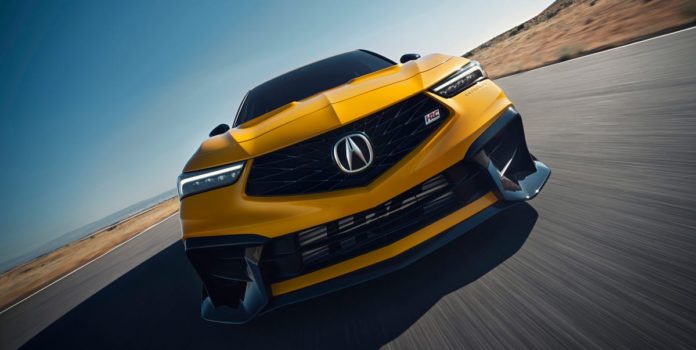- At Monterey Car Week, Acura showed off a prototype Integra Type S bursting with racing equipment from Honda Racing Corporation.
- The project cut 200 pounds from the stock Type S and added an adjustable carbon-fiber rear wing, a larger front splitter, and other racing modifications.
- The changes clearly go beyond mere cosmetic enhancement, but whether customers will be able to buy these parts as a single package has yet to be announced.
Honda Racing Corporation (HRC) already builds a race-car version of the most excellent and 10Best-winning Acura Integra Type S that competes in the TCX class. Now, the company is showcasing a what-if concept during Monterey Car Week that features go-faster parts for the Integra Type S street car, developed by HRC’s engineers.
Honda’s racing division was formerly known as HPD, for Honda Racing Development, which changed to Honda Racing Corporation, or HRC, in late 2023. This division handles the company’s IndyCar and IMSA racing efforts and will once again build engines for Formula 1 in 2026 in a partnership with Aston Martin.
The Integra Type S Prototype takes learnings from the TCX race car with a larger front splitter and cooling ducts, larger hood vents, and an adjustable carbon-fiber rear wing. Weight, already a strong suit for the stock Type S at just over 3200 pounds, has been reduced by a claimed 200 pounds, thanks to carbon-fiber hood, rear door panels, fixed-back Recaro buckets, plus replacing the rear seat with a carbon-fiber shelf designed with ferrying a spare set of wheels and tires to the track in mind, and deleting the air conditioning.
The prototype’s larger intercooler, twin oil coolers, and exhaust system come straight from the TCX car, but HRC doesn’t quote any power improvement. This overhauled Integra sits 0.6 inch lower, with new springs and dampers, an adjustable rear anti-roll bar, and front and rear camber plates.
Forged wheels are the same 9.5 x 19-inch size as the stock Type S’s, but increased negative offset widen the front and rear track widths by 1.2 inches. The prototype swaps out the stock Michelin Pilot Sport 4S tires for more aggressive Pirelli P Zero Trofeo Rs, tires that we saw improved the grip of our long-term 2019 Civic Type R to an impressive 1.05 g and reduced the 70–0 mph stopping distance to a scant 140 feet. Front brake rotors grow by 1.2 inches to 15.0 inches, and six-piston Brembo front calipers replace four-piston units from the stock Type S. Literally tying it all together is a cross-car brace where the rear seat used to live.
Although we would have liked a few more hard details about just how much this Integra’s performance has been improved, it appears that HRC is planning for its bits to have more performance-enhancing teeth than the mostly cosmetic HPD packages offered on vehicles such as the Civic and Ridgeline. But whether this concept portends selling individual bits or an entire HRC-badged package like this Integra remains to be seen.
Dave VanderWerp has spent more than 20 years in the automotive industry, in varied roles from engineering to product consulting, and now leading Car and Driver‘s vehicle-testing efforts. Dave got his very lucky start at C/D by happening to submit an unsolicited resume at just the right time to land a part-time road warrior job when he was a student at the University of Michigan, where he immediately became enthralled with the world of automotive journalism.


